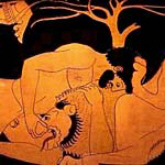Herakles' First Labour: The Nemean Lion (Continued from Herakles - the Labours) Eurystheus decreed that Herakles first Labour should be to kill and flay the Nemean Lion. King Eurystheus must have loved being in a position of power over someone as famous and powerful as Herakles, but he wasn't taking any chances - the Nemean Lion was no normal beast, but was actually one of Typhon's children, and was therefore enormous with skin that could withstand any weapon. The lion inhabited a cave on Herakles arrived at Cleonae, between When Herakles arrived at Herakles looked at his shattered club and thought a while, then placed nets across one entrance to the cave and went in by the other. Now aware that weapons were useless against the lion, Herakles began to wrestle with it. He got behind it and got it in a headlock. The lion struggled, and managed to bite off one of Herakles' fingers, but he held on, pressing hard as he could on the lion's windpipe until it choked to death. Tossing the carcass across his shoulders Herakles made his way back to Cleonae, where he found Molochus about to make a heroic sacrifice to him. Instead they sacrificed together to Zeus, then celebrated. After cutting himself a new club, Herakles carried the lion back to But the Labour would not be completed until Herakles had flayed the lion. Again, he put his brain to work, then he finally hit on the idea of using the lion's own razor-sharp claws to cut through the invulnerable skin. Soon he was able to replace the pelt of the lion of Meanwhile Eurystheus had a huge bronze urn made, which he buried up to its neck in the earth. Whenever he heard that Herakles was on his way, he would jump into the urn, where he would wait, quivering, until Herakles went away again! |
 Herakles and the Nemean lion Typhon Typhon's head was said to brush the stars. He appeared man-shaped down to the thighs, with two coiled vipers in place of legs. Attached to his hands in place of fingers were a hundred serpent heads, fifty per hand. He was winged, with dirty matted hair and beard, pointed ears, and eyes flashing fire. According to some he had two hundred hands each with fifty serpents for fingers and a hundred heads, one in human form with the rest being heads of bulls, boars, serpents, lions and leopards. As a volcano-daimon called Typhoeus he hurled red-hot rocks at the sky and storms of fire boiled from his mouth. He finally challenged Zeus himself, who imprisoned him in the lowest regions of Tartarus. Typhon fathered many monsters, including the Nemean Lion, the Hydra, the Sphinx, the Chimaera, the Harpies, Scylla and Cerberus. Herakles the 'people person' Notice that in this story, Herakles stays with a shepherd - sometimes he stays with kings; it doesn't matter to Herakles. I said previously that Herakles was "probably the greatest hero of the Classical world, and was known and loved by people all over the ancient world", and this was because people of all kinds could relate to him. They probably would have been totally overawed, and probably frightened, to welcome one of the Olympian gods or goddesses into their homes (who were fickle and unpredictable at the best of times), but they would have welcomed Herakles as one of their own. You find a similar thing in Norse mythology with Thor. He was the one the people really liked, because they felt he was on their side, that he understood them. |